Child Poverty and Social Exclusion: A UK Sociological Report
VerifiedAdded on 2022/09/13
|28
|7844
|22
Report
AI Summary
This report delves into the multifaceted issue of child poverty and social exclusion in the United Kingdom. It begins by highlighting the alarming statistics, with millions of children living in poverty, and emphasizes the severity of the situation compared to other industrialized nations. The research outlines the aims, objectives, and research questions, followed by a comprehensive review of literature that explores various types and categories of child poverty, including those affecting children with disabilities, lone-parent families, large families, and ethnic minorities. The report also examines the measures taken by the UK government to combat child poverty, specifically the Child Poverty Act, and identifies gaps in the existing literature. The methodology section details the research philosophy, design, data collection, analysis, ethical considerations, and limitations. The findings, discussion, and analysis sections reveal a strong correlation between poverty and social exclusion, highlighting the detrimental impact on children's quality of life and the perceived insufficiency of governmental efforts. The report concludes with recommendations for social service organizations to play a more proactive role in improving the lives of children affected by poverty and social exclusion in the UK, aiming to provide a better quality of life.
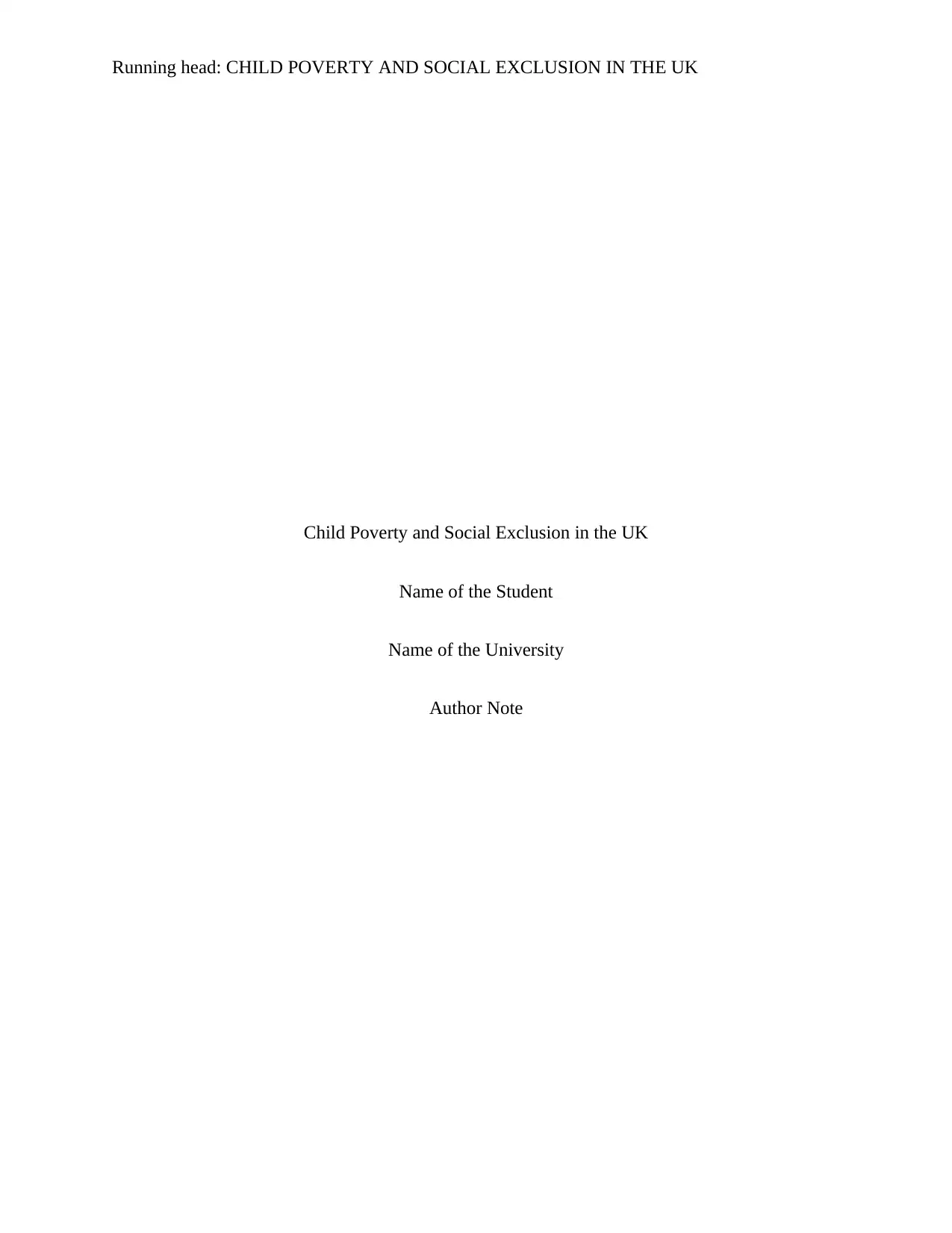
Running head: CHILD POVERTY AND SOCIAL EXCLUSION IN THE UK
Child Poverty and Social Exclusion in the UK
Name of the Student
Name of the University
Author Note
Child Poverty and Social Exclusion in the UK
Name of the Student
Name of the University
Author Note
Paraphrase This Document
Need a fresh take? Get an instant paraphrase of this document with our AI Paraphraser
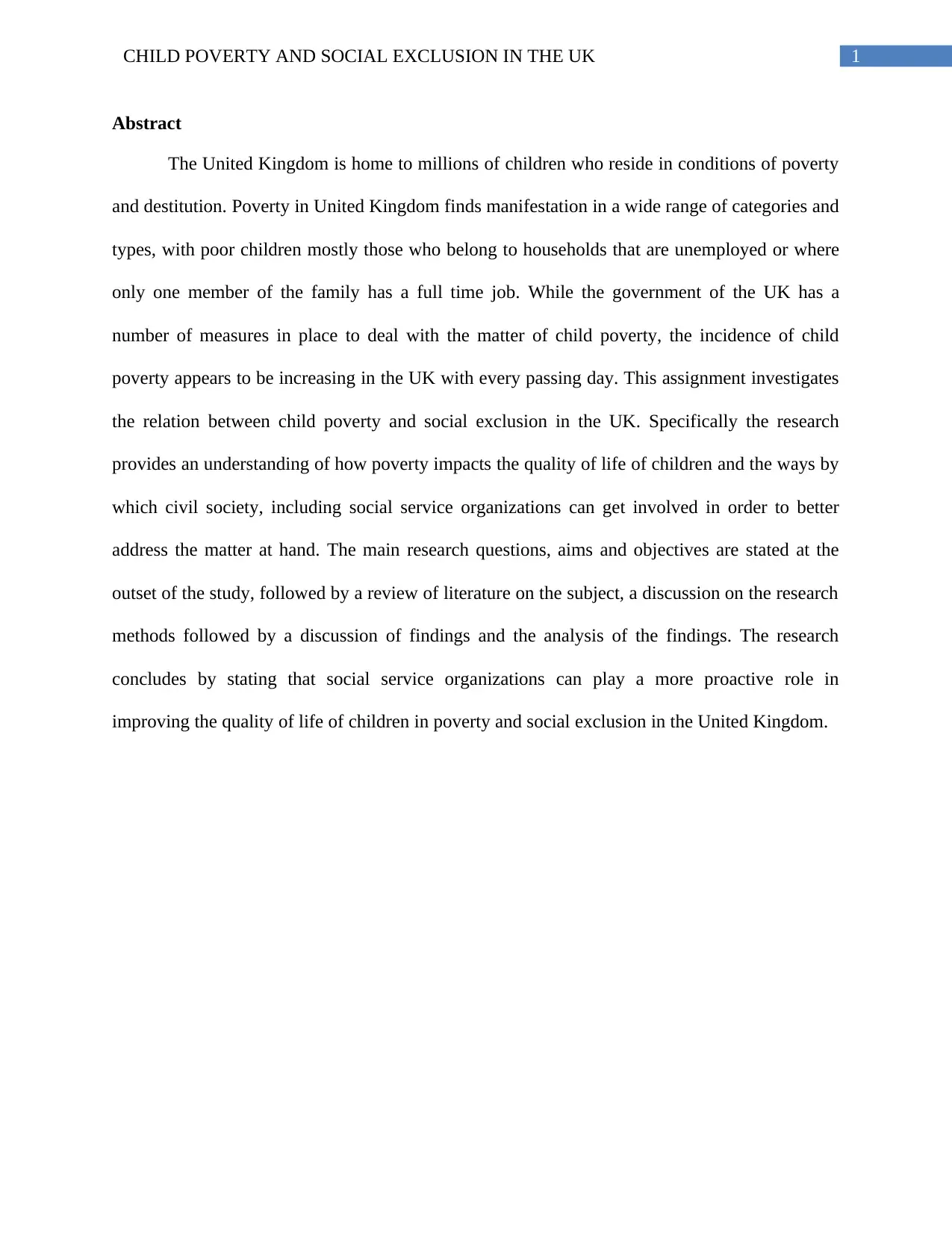
1CHILD POVERTY AND SOCIAL EXCLUSION IN THE UK
Abstract
The United Kingdom is home to millions of children who reside in conditions of poverty
and destitution. Poverty in United Kingdom finds manifestation in a wide range of categories and
types, with poor children mostly those who belong to households that are unemployed or where
only one member of the family has a full time job. While the government of the UK has a
number of measures in place to deal with the matter of child poverty, the incidence of child
poverty appears to be increasing in the UK with every passing day. This assignment investigates
the relation between child poverty and social exclusion in the UK. Specifically the research
provides an understanding of how poverty impacts the quality of life of children and the ways by
which civil society, including social service organizations can get involved in order to better
address the matter at hand. The main research questions, aims and objectives are stated at the
outset of the study, followed by a review of literature on the subject, a discussion on the research
methods followed by a discussion of findings and the analysis of the findings. The research
concludes by stating that social service organizations can play a more proactive role in
improving the quality of life of children in poverty and social exclusion in the United Kingdom.
Abstract
The United Kingdom is home to millions of children who reside in conditions of poverty
and destitution. Poverty in United Kingdom finds manifestation in a wide range of categories and
types, with poor children mostly those who belong to households that are unemployed or where
only one member of the family has a full time job. While the government of the UK has a
number of measures in place to deal with the matter of child poverty, the incidence of child
poverty appears to be increasing in the UK with every passing day. This assignment investigates
the relation between child poverty and social exclusion in the UK. Specifically the research
provides an understanding of how poverty impacts the quality of life of children and the ways by
which civil society, including social service organizations can get involved in order to better
address the matter at hand. The main research questions, aims and objectives are stated at the
outset of the study, followed by a review of literature on the subject, a discussion on the research
methods followed by a discussion of findings and the analysis of the findings. The research
concludes by stating that social service organizations can play a more proactive role in
improving the quality of life of children in poverty and social exclusion in the United Kingdom.
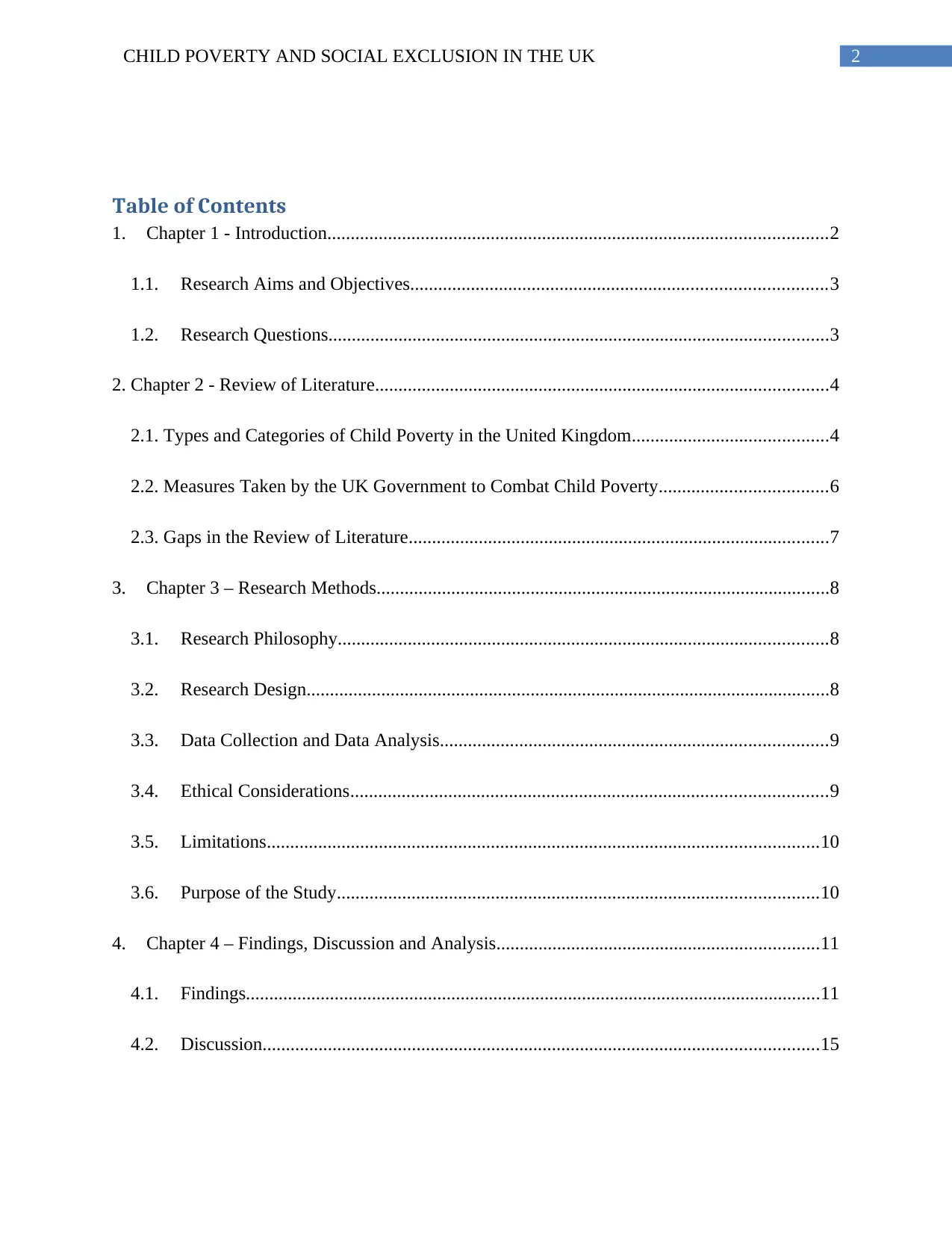
2CHILD POVERTY AND SOCIAL EXCLUSION IN THE UK
Table of Contents
1. Chapter 1 - Introduction...........................................................................................................2
1.1. Research Aims and Objectives.........................................................................................3
1.2. Research Questions...........................................................................................................3
2. Chapter 2 - Review of Literature.................................................................................................4
2.1. Types and Categories of Child Poverty in the United Kingdom..........................................4
2.2. Measures Taken by the UK Government to Combat Child Poverty....................................6
2.3. Gaps in the Review of Literature..........................................................................................7
3. Chapter 3 – Research Methods.................................................................................................8
3.1. Research Philosophy.........................................................................................................8
3.2. Research Design................................................................................................................8
3.3. Data Collection and Data Analysis...................................................................................9
3.4. Ethical Considerations......................................................................................................9
3.5. Limitations......................................................................................................................10
3.6. Purpose of the Study.......................................................................................................10
4. Chapter 4 – Findings, Discussion and Analysis.....................................................................11
4.1. Findings...........................................................................................................................11
4.2. Discussion.......................................................................................................................15
Table of Contents
1. Chapter 1 - Introduction...........................................................................................................2
1.1. Research Aims and Objectives.........................................................................................3
1.2. Research Questions...........................................................................................................3
2. Chapter 2 - Review of Literature.................................................................................................4
2.1. Types and Categories of Child Poverty in the United Kingdom..........................................4
2.2. Measures Taken by the UK Government to Combat Child Poverty....................................6
2.3. Gaps in the Review of Literature..........................................................................................7
3. Chapter 3 – Research Methods.................................................................................................8
3.1. Research Philosophy.........................................................................................................8
3.2. Research Design................................................................................................................8
3.3. Data Collection and Data Analysis...................................................................................9
3.4. Ethical Considerations......................................................................................................9
3.5. Limitations......................................................................................................................10
3.6. Purpose of the Study.......................................................................................................10
4. Chapter 4 – Findings, Discussion and Analysis.....................................................................11
4.1. Findings...........................................................................................................................11
4.2. Discussion.......................................................................................................................15
⊘ This is a preview!⊘
Do you want full access?
Subscribe today to unlock all pages.

Trusted by 1+ million students worldwide
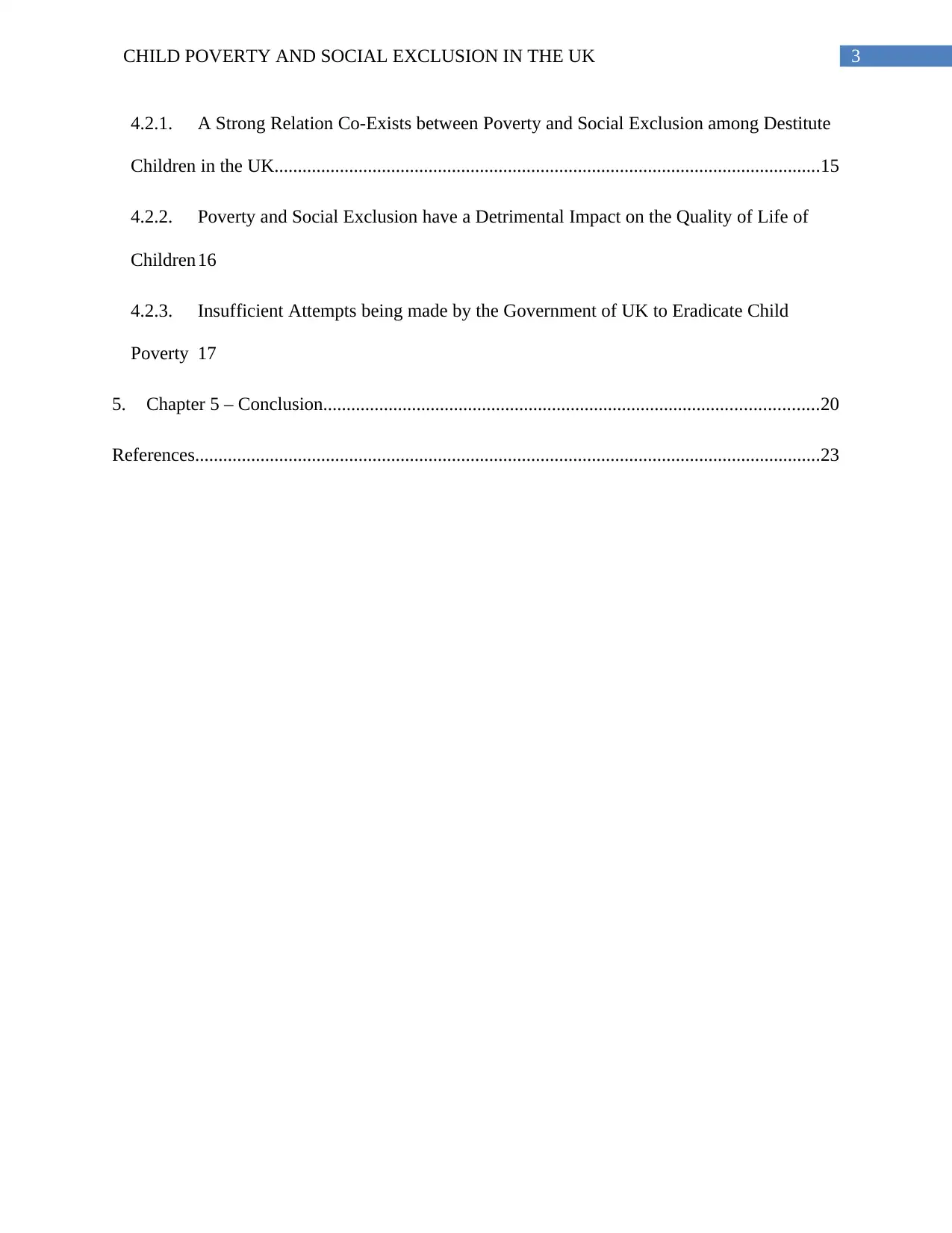
3CHILD POVERTY AND SOCIAL EXCLUSION IN THE UK
4.2.1. A Strong Relation Co-Exists between Poverty and Social Exclusion among Destitute
Children in the UK.....................................................................................................................15
4.2.2. Poverty and Social Exclusion have a Detrimental Impact on the Quality of Life of
Children16
4.2.3. Insufficient Attempts being made by the Government of UK to Eradicate Child
Poverty 17
5. Chapter 5 – Conclusion..........................................................................................................20
References......................................................................................................................................23
4.2.1. A Strong Relation Co-Exists between Poverty and Social Exclusion among Destitute
Children in the UK.....................................................................................................................15
4.2.2. Poverty and Social Exclusion have a Detrimental Impact on the Quality of Life of
Children16
4.2.3. Insufficient Attempts being made by the Government of UK to Eradicate Child
Poverty 17
5. Chapter 5 – Conclusion..........................................................................................................20
References......................................................................................................................................23
Paraphrase This Document
Need a fresh take? Get an instant paraphrase of this document with our AI Paraphraser
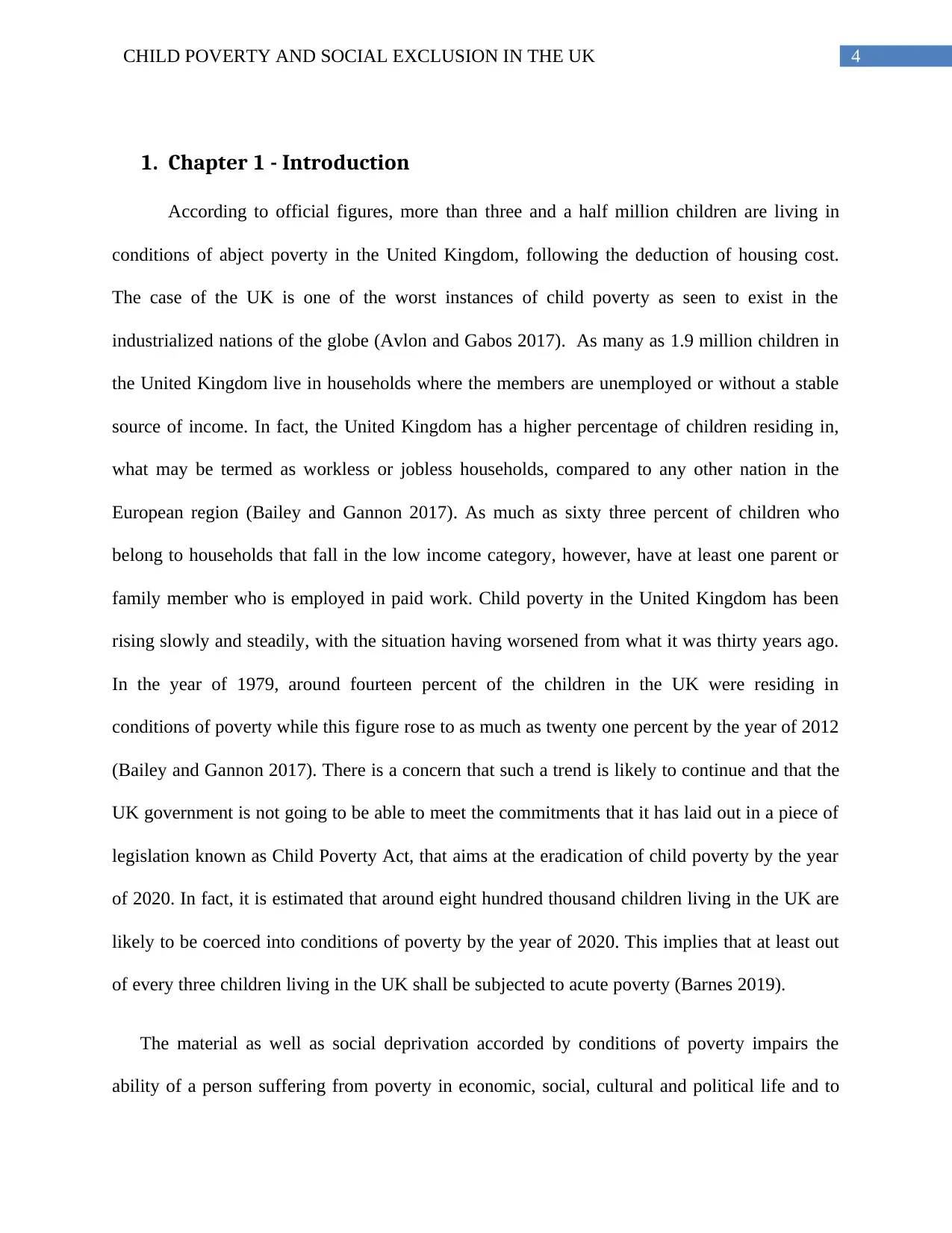
4CHILD POVERTY AND SOCIAL EXCLUSION IN THE UK
1. Chapter 1 - Introduction
According to official figures, more than three and a half million children are living in
conditions of abject poverty in the United Kingdom, following the deduction of housing cost.
The case of the UK is one of the worst instances of child poverty as seen to exist in the
industrialized nations of the globe (Avlon and Gabos 2017). As many as 1.9 million children in
the United Kingdom live in households where the members are unemployed or without a stable
source of income. In fact, the United Kingdom has a higher percentage of children residing in,
what may be termed as workless or jobless households, compared to any other nation in the
European region (Bailey and Gannon 2017). As much as sixty three percent of children who
belong to households that fall in the low income category, however, have at least one parent or
family member who is employed in paid work. Child poverty in the United Kingdom has been
rising slowly and steadily, with the situation having worsened from what it was thirty years ago.
In the year of 1979, around fourteen percent of the children in the UK were residing in
conditions of poverty while this figure rose to as much as twenty one percent by the year of 2012
(Bailey and Gannon 2017). There is a concern that such a trend is likely to continue and that the
UK government is not going to be able to meet the commitments that it has laid out in a piece of
legislation known as Child Poverty Act, that aims at the eradication of child poverty by the year
of 2020. In fact, it is estimated that around eight hundred thousand children living in the UK are
likely to be coerced into conditions of poverty by the year of 2020. This implies that at least out
of every three children living in the UK shall be subjected to acute poverty (Barnes 2019).
The material as well as social deprivation accorded by conditions of poverty impairs the
ability of a person suffering from poverty in economic, social, cultural and political life and to
1. Chapter 1 - Introduction
According to official figures, more than three and a half million children are living in
conditions of abject poverty in the United Kingdom, following the deduction of housing cost.
The case of the UK is one of the worst instances of child poverty as seen to exist in the
industrialized nations of the globe (Avlon and Gabos 2017). As many as 1.9 million children in
the United Kingdom live in households where the members are unemployed or without a stable
source of income. In fact, the United Kingdom has a higher percentage of children residing in,
what may be termed as workless or jobless households, compared to any other nation in the
European region (Bailey and Gannon 2017). As much as sixty three percent of children who
belong to households that fall in the low income category, however, have at least one parent or
family member who is employed in paid work. Child poverty in the United Kingdom has been
rising slowly and steadily, with the situation having worsened from what it was thirty years ago.
In the year of 1979, around fourteen percent of the children in the UK were residing in
conditions of poverty while this figure rose to as much as twenty one percent by the year of 2012
(Bailey and Gannon 2017). There is a concern that such a trend is likely to continue and that the
UK government is not going to be able to meet the commitments that it has laid out in a piece of
legislation known as Child Poverty Act, that aims at the eradication of child poverty by the year
of 2020. In fact, it is estimated that around eight hundred thousand children living in the UK are
likely to be coerced into conditions of poverty by the year of 2020. This implies that at least out
of every three children living in the UK shall be subjected to acute poverty (Barnes 2019).
The material as well as social deprivation accorded by conditions of poverty impairs the
ability of a person suffering from poverty in economic, social, cultural and political life and to
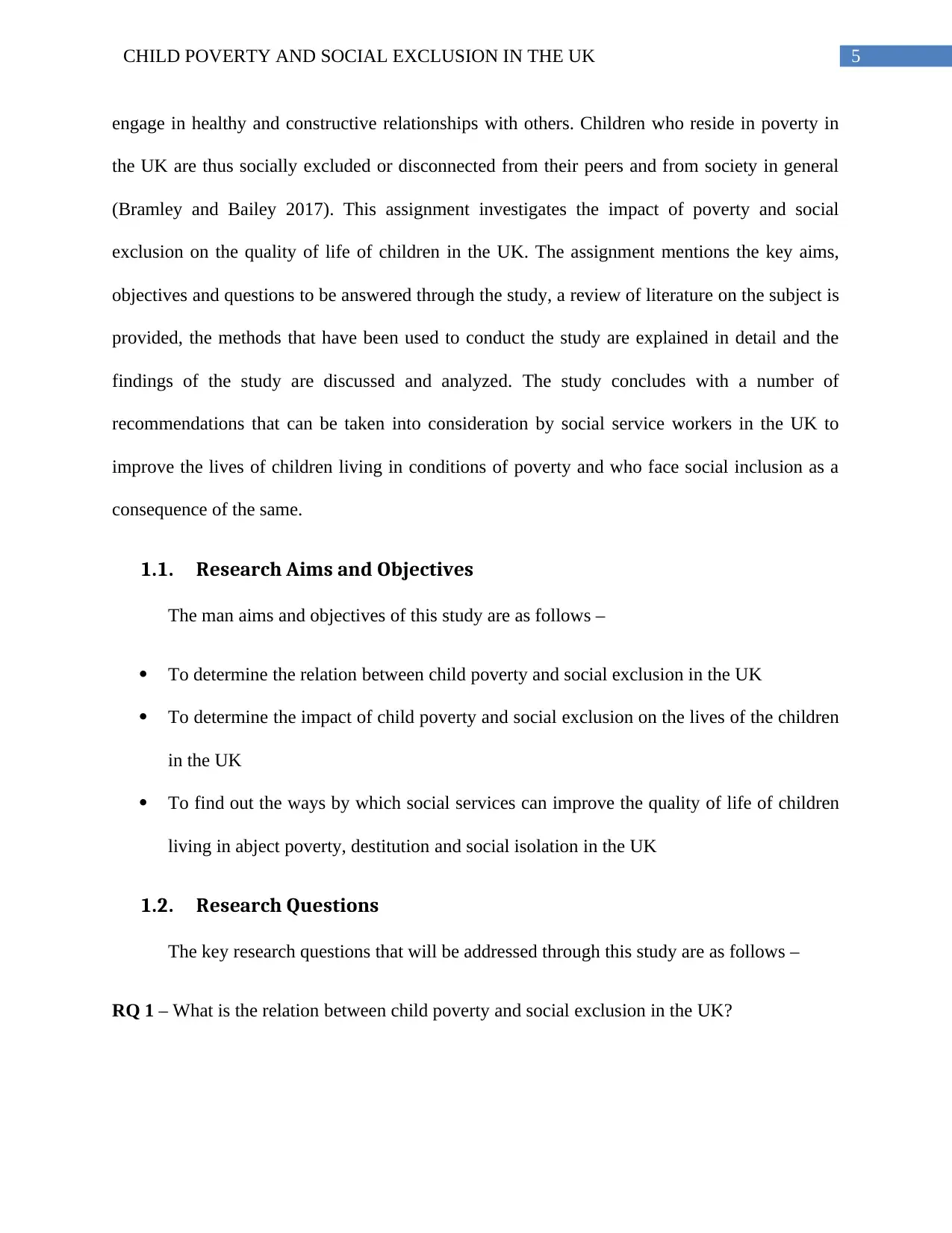
5CHILD POVERTY AND SOCIAL EXCLUSION IN THE UK
engage in healthy and constructive relationships with others. Children who reside in poverty in
the UK are thus socially excluded or disconnected from their peers and from society in general
(Bramley and Bailey 2017). This assignment investigates the impact of poverty and social
exclusion on the quality of life of children in the UK. The assignment mentions the key aims,
objectives and questions to be answered through the study, a review of literature on the subject is
provided, the methods that have been used to conduct the study are explained in detail and the
findings of the study are discussed and analyzed. The study concludes with a number of
recommendations that can be taken into consideration by social service workers in the UK to
improve the lives of children living in conditions of poverty and who face social inclusion as a
consequence of the same.
1.1. Research Aims and Objectives
The man aims and objectives of this study are as follows –
To determine the relation between child poverty and social exclusion in the UK
To determine the impact of child poverty and social exclusion on the lives of the children
in the UK
To find out the ways by which social services can improve the quality of life of children
living in abject poverty, destitution and social isolation in the UK
1.2. Research Questions
The key research questions that will be addressed through this study are as follows –
RQ 1 – What is the relation between child poverty and social exclusion in the UK?
engage in healthy and constructive relationships with others. Children who reside in poverty in
the UK are thus socially excluded or disconnected from their peers and from society in general
(Bramley and Bailey 2017). This assignment investigates the impact of poverty and social
exclusion on the quality of life of children in the UK. The assignment mentions the key aims,
objectives and questions to be answered through the study, a review of literature on the subject is
provided, the methods that have been used to conduct the study are explained in detail and the
findings of the study are discussed and analyzed. The study concludes with a number of
recommendations that can be taken into consideration by social service workers in the UK to
improve the lives of children living in conditions of poverty and who face social inclusion as a
consequence of the same.
1.1. Research Aims and Objectives
The man aims and objectives of this study are as follows –
To determine the relation between child poverty and social exclusion in the UK
To determine the impact of child poverty and social exclusion on the lives of the children
in the UK
To find out the ways by which social services can improve the quality of life of children
living in abject poverty, destitution and social isolation in the UK
1.2. Research Questions
The key research questions that will be addressed through this study are as follows –
RQ 1 – What is the relation between child poverty and social exclusion in the UK?
⊘ This is a preview!⊘
Do you want full access?
Subscribe today to unlock all pages.

Trusted by 1+ million students worldwide
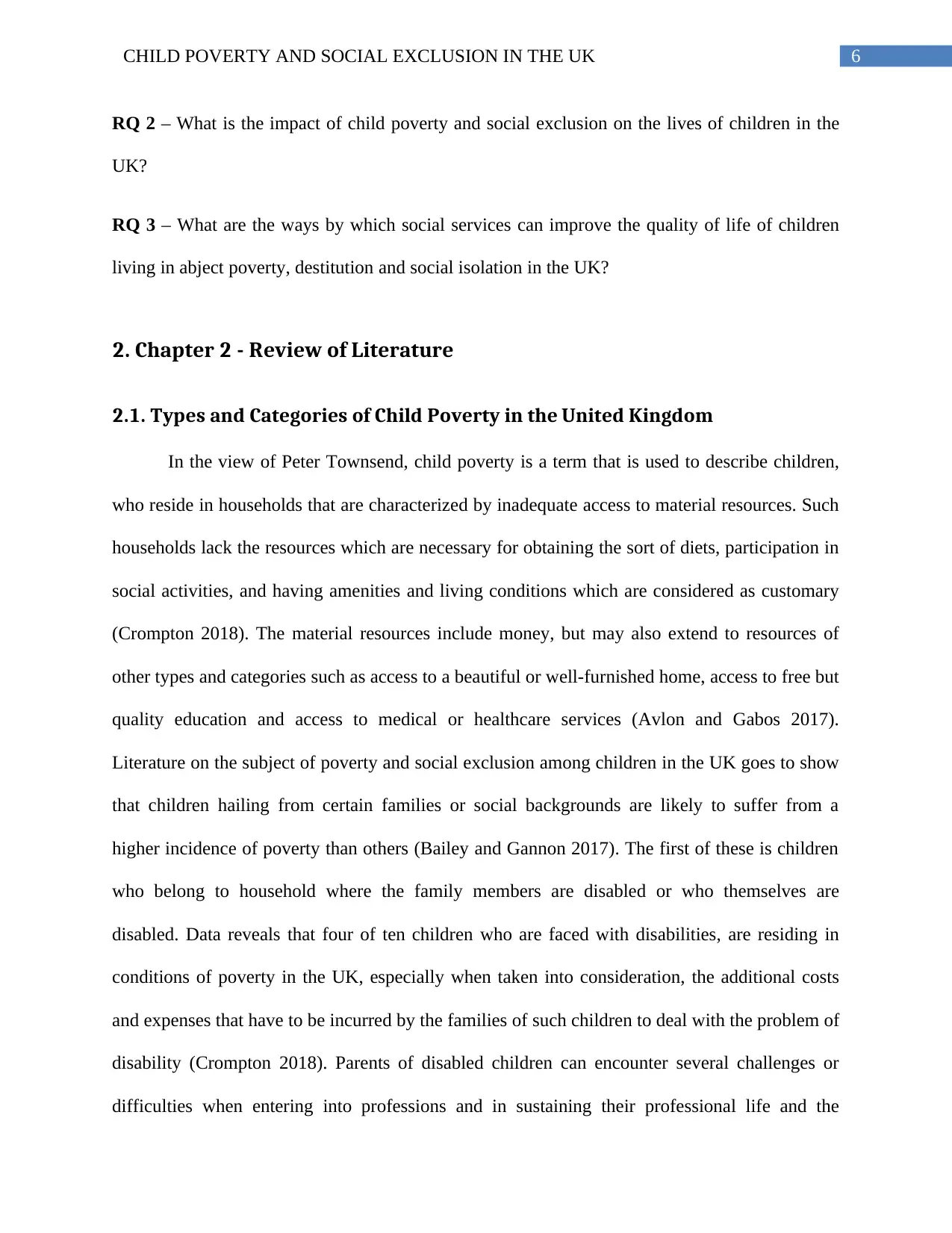
6CHILD POVERTY AND SOCIAL EXCLUSION IN THE UK
RQ 2 – What is the impact of child poverty and social exclusion on the lives of children in the
UK?
RQ 3 – What are the ways by which social services can improve the quality of life of children
living in abject poverty, destitution and social isolation in the UK?
2. Chapter 2 - Review of Literature
2.1. Types and Categories of Child Poverty in the United Kingdom
In the view of Peter Townsend, child poverty is a term that is used to describe children,
who reside in households that are characterized by inadequate access to material resources. Such
households lack the resources which are necessary for obtaining the sort of diets, participation in
social activities, and having amenities and living conditions which are considered as customary
(Crompton 2018). The material resources include money, but may also extend to resources of
other types and categories such as access to a beautiful or well-furnished home, access to free but
quality education and access to medical or healthcare services (Avlon and Gabos 2017).
Literature on the subject of poverty and social exclusion among children in the UK goes to show
that children hailing from certain families or social backgrounds are likely to suffer from a
higher incidence of poverty than others (Bailey and Gannon 2017). The first of these is children
who belong to household where the family members are disabled or who themselves are
disabled. Data reveals that four of ten children who are faced with disabilities, are residing in
conditions of poverty in the UK, especially when taken into consideration, the additional costs
and expenses that have to be incurred by the families of such children to deal with the problem of
disability (Crompton 2018). Parents of disabled children can encounter several challenges or
difficulties when entering into professions and in sustaining their professional life and the
RQ 2 – What is the impact of child poverty and social exclusion on the lives of children in the
UK?
RQ 3 – What are the ways by which social services can improve the quality of life of children
living in abject poverty, destitution and social isolation in the UK?
2. Chapter 2 - Review of Literature
2.1. Types and Categories of Child Poverty in the United Kingdom
In the view of Peter Townsend, child poverty is a term that is used to describe children,
who reside in households that are characterized by inadequate access to material resources. Such
households lack the resources which are necessary for obtaining the sort of diets, participation in
social activities, and having amenities and living conditions which are considered as customary
(Crompton 2018). The material resources include money, but may also extend to resources of
other types and categories such as access to a beautiful or well-furnished home, access to free but
quality education and access to medical or healthcare services (Avlon and Gabos 2017).
Literature on the subject of poverty and social exclusion among children in the UK goes to show
that children hailing from certain families or social backgrounds are likely to suffer from a
higher incidence of poverty than others (Bailey and Gannon 2017). The first of these is children
who belong to household where the family members are disabled or who themselves are
disabled. Data reveals that four of ten children who are faced with disabilities, are residing in
conditions of poverty in the UK, especially when taken into consideration, the additional costs
and expenses that have to be incurred by the families of such children to deal with the problem of
disability (Crompton 2018). Parents of disabled children can encounter several challenges or
difficulties when entering into professions and in sustaining their professional life and the
Paraphrase This Document
Need a fresh take? Get an instant paraphrase of this document with our AI Paraphraser
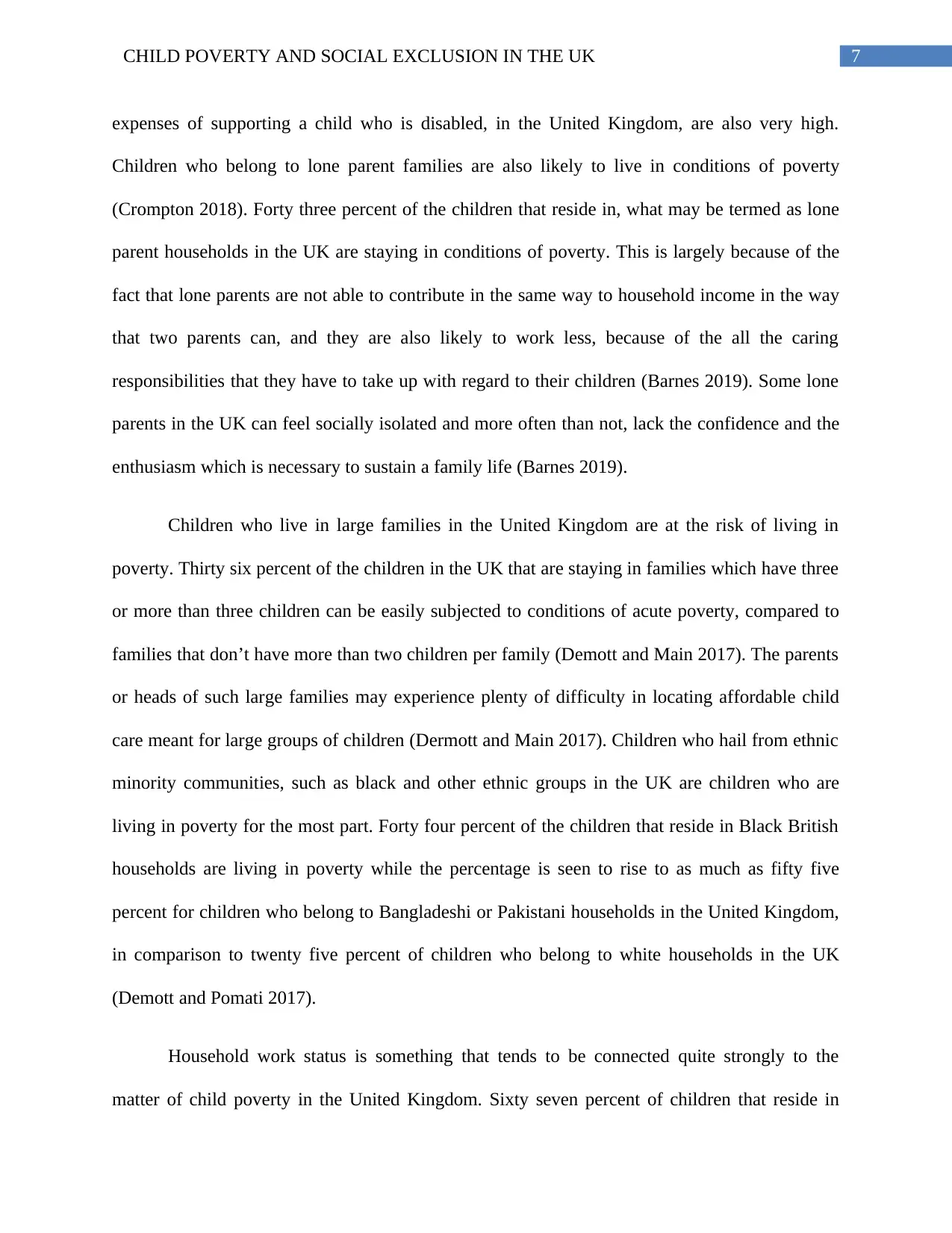
7CHILD POVERTY AND SOCIAL EXCLUSION IN THE UK
expenses of supporting a child who is disabled, in the United Kingdom, are also very high.
Children who belong to lone parent families are also likely to live in conditions of poverty
(Crompton 2018). Forty three percent of the children that reside in, what may be termed as lone
parent households in the UK are staying in conditions of poverty. This is largely because of the
fact that lone parents are not able to contribute in the same way to household income in the way
that two parents can, and they are also likely to work less, because of the all the caring
responsibilities that they have to take up with regard to their children (Barnes 2019). Some lone
parents in the UK can feel socially isolated and more often than not, lack the confidence and the
enthusiasm which is necessary to sustain a family life (Barnes 2019).
Children who live in large families in the United Kingdom are at the risk of living in
poverty. Thirty six percent of the children in the UK that are staying in families which have three
or more than three children can be easily subjected to conditions of acute poverty, compared to
families that don’t have more than two children per family (Demott and Main 2017). The parents
or heads of such large families may experience plenty of difficulty in locating affordable child
care meant for large groups of children (Dermott and Main 2017). Children who hail from ethnic
minority communities, such as black and other ethnic groups in the UK are children who are
living in poverty for the most part. Forty four percent of the children that reside in Black British
households are living in poverty while the percentage is seen to rise to as much as fifty five
percent for children who belong to Bangladeshi or Pakistani households in the United Kingdom,
in comparison to twenty five percent of children who belong to white households in the UK
(Demott and Pomati 2017).
Household work status is something that tends to be connected quite strongly to the
matter of child poverty in the United Kingdom. Sixty seven percent of children that reside in
expenses of supporting a child who is disabled, in the United Kingdom, are also very high.
Children who belong to lone parent families are also likely to live in conditions of poverty
(Crompton 2018). Forty three percent of the children that reside in, what may be termed as lone
parent households in the UK are staying in conditions of poverty. This is largely because of the
fact that lone parents are not able to contribute in the same way to household income in the way
that two parents can, and they are also likely to work less, because of the all the caring
responsibilities that they have to take up with regard to their children (Barnes 2019). Some lone
parents in the UK can feel socially isolated and more often than not, lack the confidence and the
enthusiasm which is necessary to sustain a family life (Barnes 2019).
Children who live in large families in the United Kingdom are at the risk of living in
poverty. Thirty six percent of the children in the UK that are staying in families which have three
or more than three children can be easily subjected to conditions of acute poverty, compared to
families that don’t have more than two children per family (Demott and Main 2017). The parents
or heads of such large families may experience plenty of difficulty in locating affordable child
care meant for large groups of children (Dermott and Main 2017). Children who hail from ethnic
minority communities, such as black and other ethnic groups in the UK are children who are
living in poverty for the most part. Forty four percent of the children that reside in Black British
households are living in poverty while the percentage is seen to rise to as much as fifty five
percent for children who belong to Bangladeshi or Pakistani households in the United Kingdom,
in comparison to twenty five percent of children who belong to white households in the UK
(Demott and Pomati 2017).
Household work status is something that tends to be connected quite strongly to the
matter of child poverty in the United Kingdom. Sixty seven percent of children that reside in
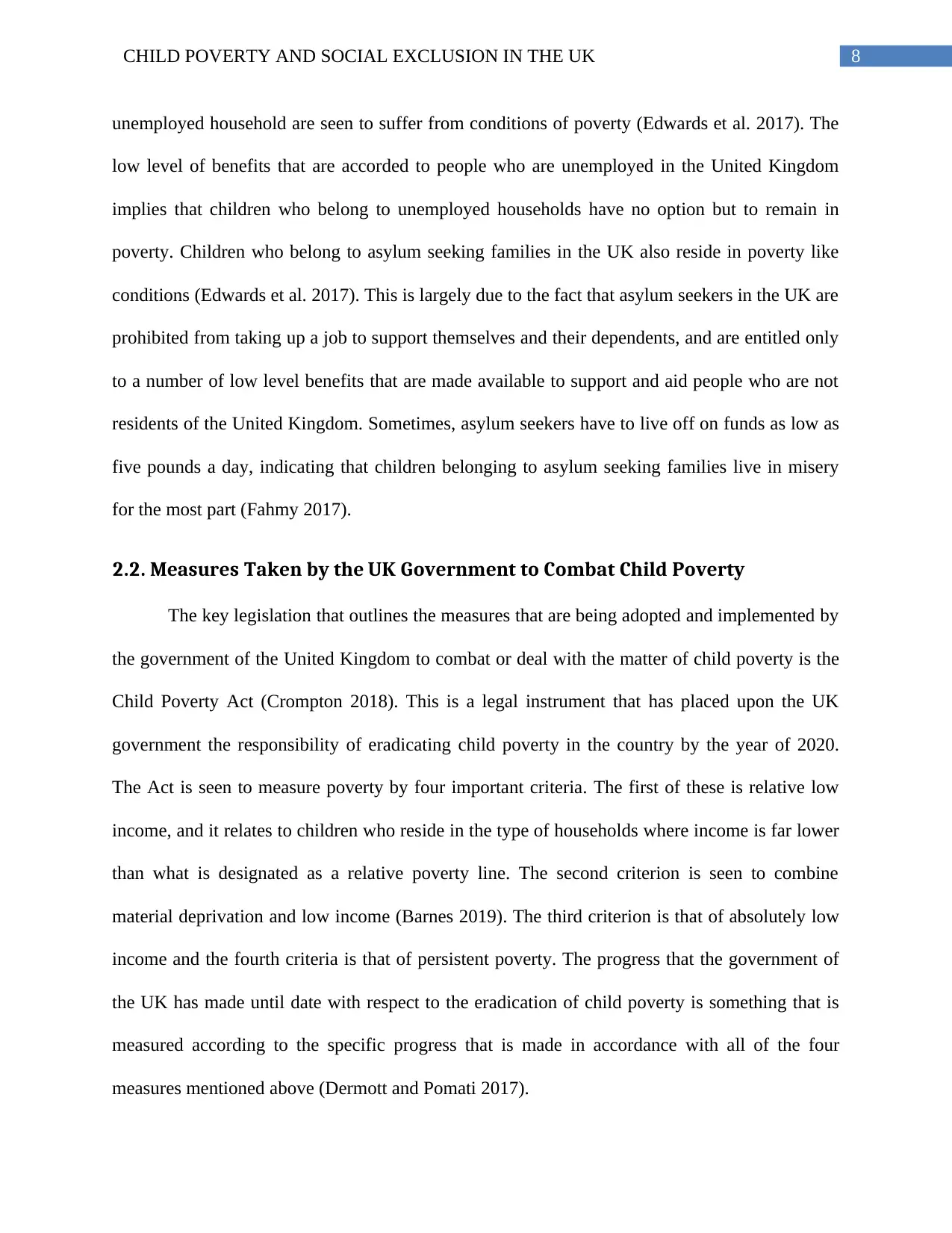
8CHILD POVERTY AND SOCIAL EXCLUSION IN THE UK
unemployed household are seen to suffer from conditions of poverty (Edwards et al. 2017). The
low level of benefits that are accorded to people who are unemployed in the United Kingdom
implies that children who belong to unemployed households have no option but to remain in
poverty. Children who belong to asylum seeking families in the UK also reside in poverty like
conditions (Edwards et al. 2017). This is largely due to the fact that asylum seekers in the UK are
prohibited from taking up a job to support themselves and their dependents, and are entitled only
to a number of low level benefits that are made available to support and aid people who are not
residents of the United Kingdom. Sometimes, asylum seekers have to live off on funds as low as
five pounds a day, indicating that children belonging to asylum seeking families live in misery
for the most part (Fahmy 2017).
2.2. Measures Taken by the UK Government to Combat Child Poverty
The key legislation that outlines the measures that are being adopted and implemented by
the government of the United Kingdom to combat or deal with the matter of child poverty is the
Child Poverty Act (Crompton 2018). This is a legal instrument that has placed upon the UK
government the responsibility of eradicating child poverty in the country by the year of 2020.
The Act is seen to measure poverty by four important criteria. The first of these is relative low
income, and it relates to children who reside in the type of households where income is far lower
than what is designated as a relative poverty line. The second criterion is seen to combine
material deprivation and low income (Barnes 2019). The third criterion is that of absolutely low
income and the fourth criteria is that of persistent poverty. The progress that the government of
the UK has made until date with respect to the eradication of child poverty is something that is
measured according to the specific progress that is made in accordance with all of the four
measures mentioned above (Dermott and Pomati 2017).
unemployed household are seen to suffer from conditions of poverty (Edwards et al. 2017). The
low level of benefits that are accorded to people who are unemployed in the United Kingdom
implies that children who belong to unemployed households have no option but to remain in
poverty. Children who belong to asylum seeking families in the UK also reside in poverty like
conditions (Edwards et al. 2017). This is largely due to the fact that asylum seekers in the UK are
prohibited from taking up a job to support themselves and their dependents, and are entitled only
to a number of low level benefits that are made available to support and aid people who are not
residents of the United Kingdom. Sometimes, asylum seekers have to live off on funds as low as
five pounds a day, indicating that children belonging to asylum seeking families live in misery
for the most part (Fahmy 2017).
2.2. Measures Taken by the UK Government to Combat Child Poverty
The key legislation that outlines the measures that are being adopted and implemented by
the government of the United Kingdom to combat or deal with the matter of child poverty is the
Child Poverty Act (Crompton 2018). This is a legal instrument that has placed upon the UK
government the responsibility of eradicating child poverty in the country by the year of 2020.
The Act is seen to measure poverty by four important criteria. The first of these is relative low
income, and it relates to children who reside in the type of households where income is far lower
than what is designated as a relative poverty line. The second criterion is seen to combine
material deprivation and low income (Barnes 2019). The third criterion is that of absolutely low
income and the fourth criteria is that of persistent poverty. The progress that the government of
the UK has made until date with respect to the eradication of child poverty is something that is
measured according to the specific progress that is made in accordance with all of the four
measures mentioned above (Dermott and Pomati 2017).
⊘ This is a preview!⊘
Do you want full access?
Subscribe today to unlock all pages.

Trusted by 1+ million students worldwide
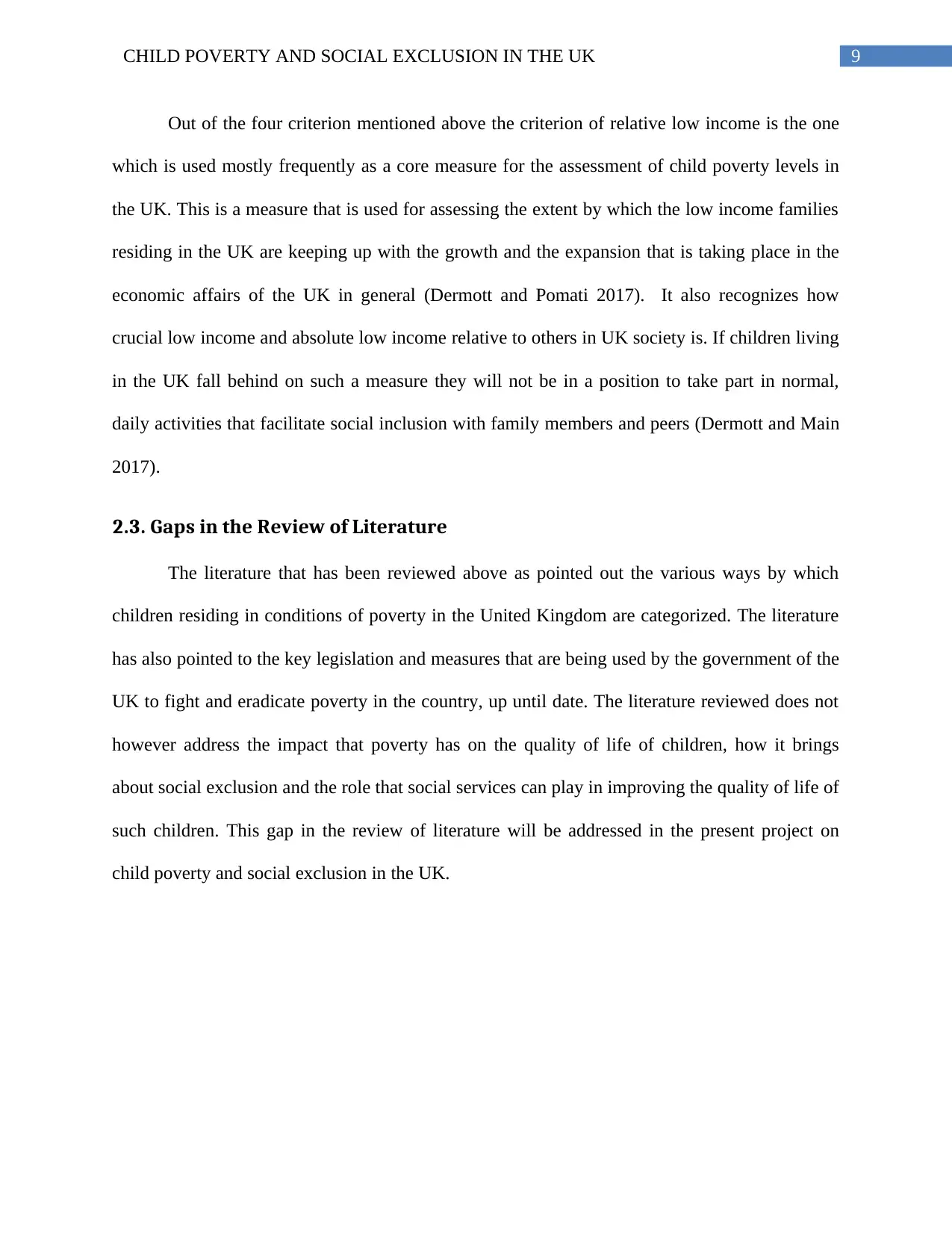
9CHILD POVERTY AND SOCIAL EXCLUSION IN THE UK
Out of the four criterion mentioned above the criterion of relative low income is the one
which is used mostly frequently as a core measure for the assessment of child poverty levels in
the UK. This is a measure that is used for assessing the extent by which the low income families
residing in the UK are keeping up with the growth and the expansion that is taking place in the
economic affairs of the UK in general (Dermott and Pomati 2017). It also recognizes how
crucial low income and absolute low income relative to others in UK society is. If children living
in the UK fall behind on such a measure they will not be in a position to take part in normal,
daily activities that facilitate social inclusion with family members and peers (Dermott and Main
2017).
2.3. Gaps in the Review of Literature
The literature that has been reviewed above as pointed out the various ways by which
children residing in conditions of poverty in the United Kingdom are categorized. The literature
has also pointed to the key legislation and measures that are being used by the government of the
UK to fight and eradicate poverty in the country, up until date. The literature reviewed does not
however address the impact that poverty has on the quality of life of children, how it brings
about social exclusion and the role that social services can play in improving the quality of life of
such children. This gap in the review of literature will be addressed in the present project on
child poverty and social exclusion in the UK.
Out of the four criterion mentioned above the criterion of relative low income is the one
which is used mostly frequently as a core measure for the assessment of child poverty levels in
the UK. This is a measure that is used for assessing the extent by which the low income families
residing in the UK are keeping up with the growth and the expansion that is taking place in the
economic affairs of the UK in general (Dermott and Pomati 2017). It also recognizes how
crucial low income and absolute low income relative to others in UK society is. If children living
in the UK fall behind on such a measure they will not be in a position to take part in normal,
daily activities that facilitate social inclusion with family members and peers (Dermott and Main
2017).
2.3. Gaps in the Review of Literature
The literature that has been reviewed above as pointed out the various ways by which
children residing in conditions of poverty in the United Kingdom are categorized. The literature
has also pointed to the key legislation and measures that are being used by the government of the
UK to fight and eradicate poverty in the country, up until date. The literature reviewed does not
however address the impact that poverty has on the quality of life of children, how it brings
about social exclusion and the role that social services can play in improving the quality of life of
such children. This gap in the review of literature will be addressed in the present project on
child poverty and social exclusion in the UK.
Paraphrase This Document
Need a fresh take? Get an instant paraphrase of this document with our AI Paraphraser
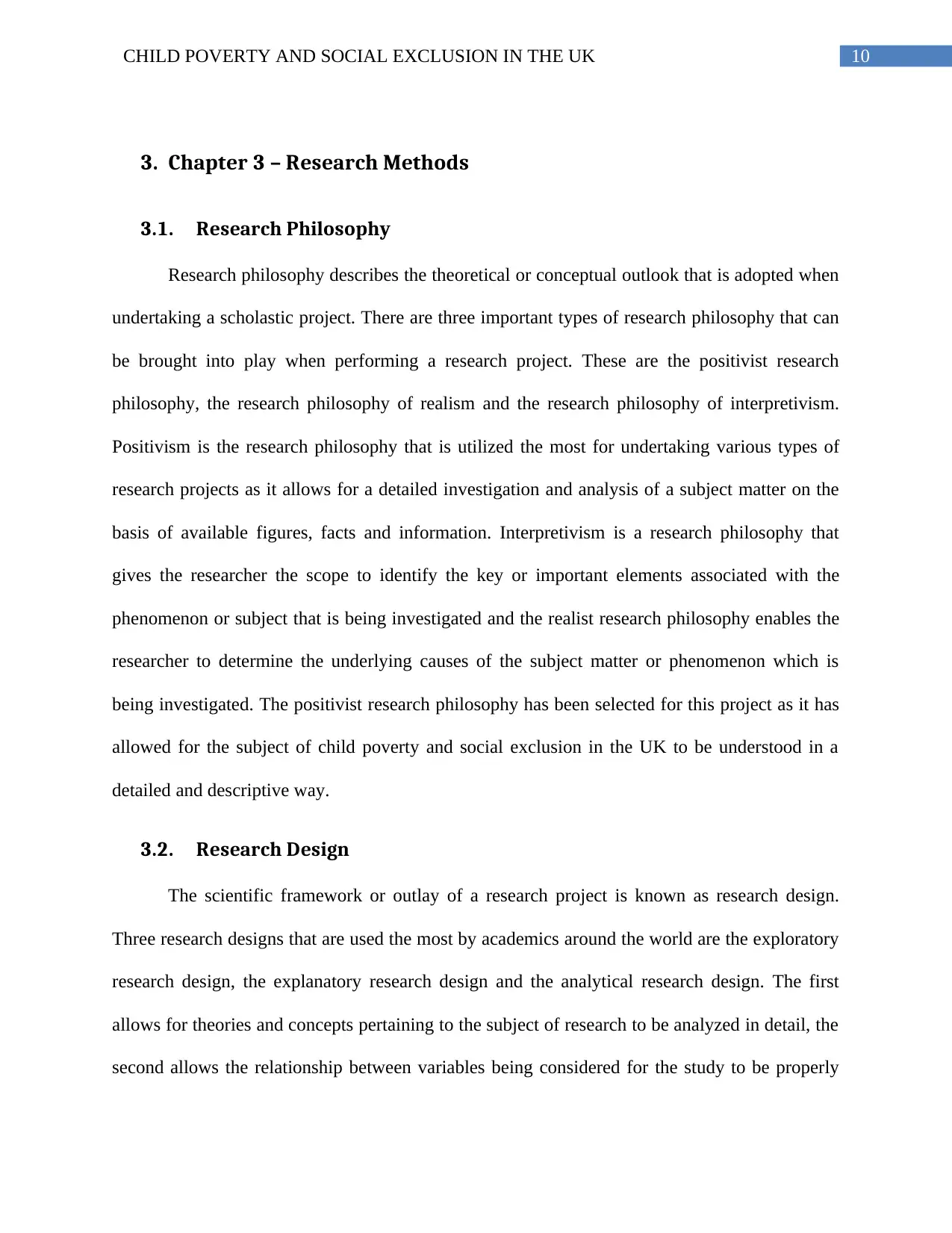
10CHILD POVERTY AND SOCIAL EXCLUSION IN THE UK
3. Chapter 3 – Research Methods
3.1. Research Philosophy
Research philosophy describes the theoretical or conceptual outlook that is adopted when
undertaking a scholastic project. There are three important types of research philosophy that can
be brought into play when performing a research project. These are the positivist research
philosophy, the research philosophy of realism and the research philosophy of interpretivism.
Positivism is the research philosophy that is utilized the most for undertaking various types of
research projects as it allows for a detailed investigation and analysis of a subject matter on the
basis of available figures, facts and information. Interpretivism is a research philosophy that
gives the researcher the scope to identify the key or important elements associated with the
phenomenon or subject that is being investigated and the realist research philosophy enables the
researcher to determine the underlying causes of the subject matter or phenomenon which is
being investigated. The positivist research philosophy has been selected for this project as it has
allowed for the subject of child poverty and social exclusion in the UK to be understood in a
detailed and descriptive way.
3.2. Research Design
The scientific framework or outlay of a research project is known as research design.
Three research designs that are used the most by academics around the world are the exploratory
research design, the explanatory research design and the analytical research design. The first
allows for theories and concepts pertaining to the subject of research to be analyzed in detail, the
second allows the relationship between variables being considered for the study to be properly
3. Chapter 3 – Research Methods
3.1. Research Philosophy
Research philosophy describes the theoretical or conceptual outlook that is adopted when
undertaking a scholastic project. There are three important types of research philosophy that can
be brought into play when performing a research project. These are the positivist research
philosophy, the research philosophy of realism and the research philosophy of interpretivism.
Positivism is the research philosophy that is utilized the most for undertaking various types of
research projects as it allows for a detailed investigation and analysis of a subject matter on the
basis of available figures, facts and information. Interpretivism is a research philosophy that
gives the researcher the scope to identify the key or important elements associated with the
phenomenon or subject that is being investigated and the realist research philosophy enables the
researcher to determine the underlying causes of the subject matter or phenomenon which is
being investigated. The positivist research philosophy has been selected for this project as it has
allowed for the subject of child poverty and social exclusion in the UK to be understood in a
detailed and descriptive way.
3.2. Research Design
The scientific framework or outlay of a research project is known as research design.
Three research designs that are used the most by academics around the world are the exploratory
research design, the explanatory research design and the analytical research design. The first
allows for theories and concepts pertaining to the subject of research to be analyzed in detail, the
second allows the relationship between variables being considered for the study to be properly
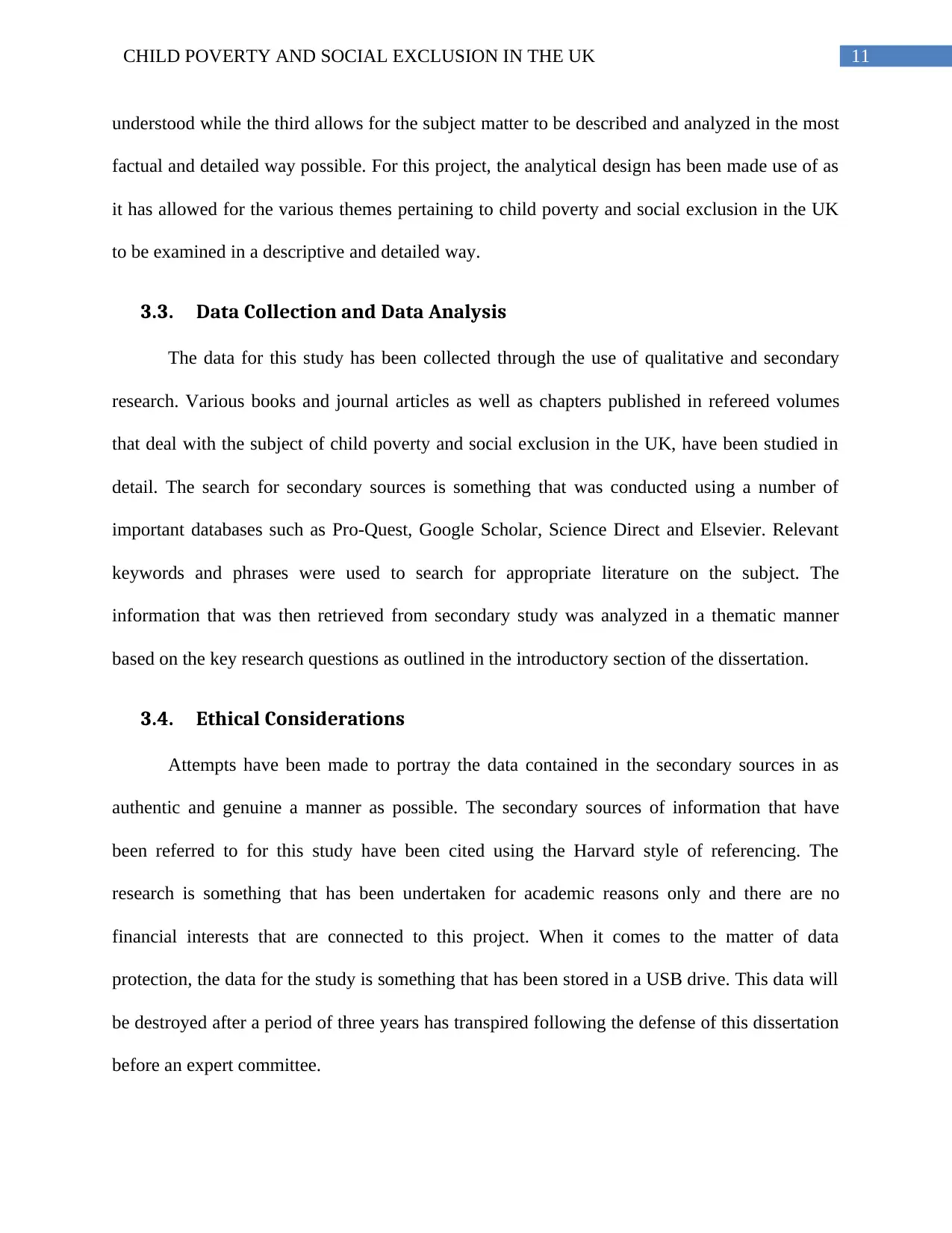
11CHILD POVERTY AND SOCIAL EXCLUSION IN THE UK
understood while the third allows for the subject matter to be described and analyzed in the most
factual and detailed way possible. For this project, the analytical design has been made use of as
it has allowed for the various themes pertaining to child poverty and social exclusion in the UK
to be examined in a descriptive and detailed way.
3.3. Data Collection and Data Analysis
The data for this study has been collected through the use of qualitative and secondary
research. Various books and journal articles as well as chapters published in refereed volumes
that deal with the subject of child poverty and social exclusion in the UK, have been studied in
detail. The search for secondary sources is something that was conducted using a number of
important databases such as Pro-Quest, Google Scholar, Science Direct and Elsevier. Relevant
keywords and phrases were used to search for appropriate literature on the subject. The
information that was then retrieved from secondary study was analyzed in a thematic manner
based on the key research questions as outlined in the introductory section of the dissertation.
3.4. Ethical Considerations
Attempts have been made to portray the data contained in the secondary sources in as
authentic and genuine a manner as possible. The secondary sources of information that have
been referred to for this study have been cited using the Harvard style of referencing. The
research is something that has been undertaken for academic reasons only and there are no
financial interests that are connected to this project. When it comes to the matter of data
protection, the data for the study is something that has been stored in a USB drive. This data will
be destroyed after a period of three years has transpired following the defense of this dissertation
before an expert committee.
understood while the third allows for the subject matter to be described and analyzed in the most
factual and detailed way possible. For this project, the analytical design has been made use of as
it has allowed for the various themes pertaining to child poverty and social exclusion in the UK
to be examined in a descriptive and detailed way.
3.3. Data Collection and Data Analysis
The data for this study has been collected through the use of qualitative and secondary
research. Various books and journal articles as well as chapters published in refereed volumes
that deal with the subject of child poverty and social exclusion in the UK, have been studied in
detail. The search for secondary sources is something that was conducted using a number of
important databases such as Pro-Quest, Google Scholar, Science Direct and Elsevier. Relevant
keywords and phrases were used to search for appropriate literature on the subject. The
information that was then retrieved from secondary study was analyzed in a thematic manner
based on the key research questions as outlined in the introductory section of the dissertation.
3.4. Ethical Considerations
Attempts have been made to portray the data contained in the secondary sources in as
authentic and genuine a manner as possible. The secondary sources of information that have
been referred to for this study have been cited using the Harvard style of referencing. The
research is something that has been undertaken for academic reasons only and there are no
financial interests that are connected to this project. When it comes to the matter of data
protection, the data for the study is something that has been stored in a USB drive. This data will
be destroyed after a period of three years has transpired following the defense of this dissertation
before an expert committee.
⊘ This is a preview!⊘
Do you want full access?
Subscribe today to unlock all pages.

Trusted by 1+ million students worldwide
1 out of 28
Related Documents
Your All-in-One AI-Powered Toolkit for Academic Success.
+13062052269
info@desklib.com
Available 24*7 on WhatsApp / Email
![[object Object]](/_next/static/media/star-bottom.7253800d.svg)
Unlock your academic potential
Copyright © 2020–2025 A2Z Services. All Rights Reserved. Developed and managed by ZUCOL.





